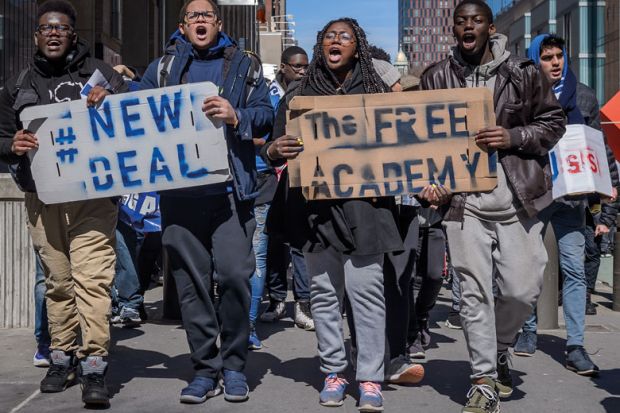The US public appears increasingly supportive of the idea of taxpayer-subsidised higher education, even as the Biden administration and Congress take a tentative approach, sociologists say.
The researchers, Brian Powell of Indiana University and Natasha Quadlin of the University of California, Los Angeles, have just completed a book – Who Should Pay? Higher Education, Responsibility, and the Public – that they expected would show American intransigence on the question of post-secondary financing.
But as they moved through a series of opinion polls on the question, Professor Powell said, they became surprised to see what they now recognise as a startling rate of growth over time in the share of Americans who believe that government should bear most responsibility for funding college costs.
“These findings were not at all what we actually had anticipated,” he said.
Their core data is a set of three public opinion surveys and interviews – in 2010, 2015 and 2019 – aimed at testing that specific question on share of responsibility for funding. The first showed that nearly two-thirds of those asked believed that parents and students should bear primary responsibility.
That 2010 baseline reflected an attitude understood to have been consistent for decades, Professor Powell said. But in the 2015 survey, that level dropped to 50 per cent. Then the 2019 poll showed it below 40 per cent. The proportion of those believing government should be primarily responsible for college costs grew over those periods from 9 per cent to 19 per cent to 25 per cent.
While that still leaves parents and students viewed as most responsible for college costs, the rapid pace of change over the past decade suggests an imminent flip in that balance, Professor Powell said.
The findings come, however, while the Biden administration has struggled to convince Congress to enact its campaign-trail commitment of making all public two-year institutions tuition-free. The administration has also refused to implement on its own Mr Biden’s vow during the 2020 election season to forgive $10,000 (£7,782) per person in student loan debt.
The administration instead has engaged in a running series of announcements of targeted loan relief. In its most recent episode, the US Department of Education identified another 40,000 borrowers who would receive immediate student debt forgiveness because they worked in eligible public service jobs, and outlined new steps to help at least 3.6 million other borrowers move closer to their forgiveness.
In total, the administration has now forgiven more than $17 billion in student debt owed by 700,000 borrowers, due to specific circumstances, such as disabilities and fraud by for-profit institutions. But those numbers remain a fraction of the more than 43 million borrowers who still owe the federal government more than $1.6 trillion in student loan debt – a number larger than that of any sector of borrowing other than home mortgages.
The US Department of Education assured administration officials more than a year ago that the president had the legal authority to cancel that debt without the approval of Congress. Administration officials have described themselves since then as continuing to assess implementation.
The US undersecretary of education, James Kvaal – former president of the Institute for College Access and Success, a group founded to help reduce student loan debt – reiterated that position while announcing the relief for the latest group of 40,000 borrowers.
“We’re working really, really hard where there’s clear authority for us to help borrowers,” Mr Kvaal told Times Higher Education at a news briefing. “And every day we’re engaged in conversations about how to make these programmes work better, and how to get the borrowers the relief that they’re entitled to.”
Register to continue
Why register?
- Registration is free and only takes a moment
- Once registered, you can read 3 articles a month
- Sign up for our newsletter
Subscribe
Or subscribe for unlimited access to:
- Unlimited access to news, views, insights & reviews
- Digital editions
- Digital access to THE’s university and college rankings analysis
Already registered or a current subscriber? Login








